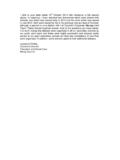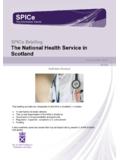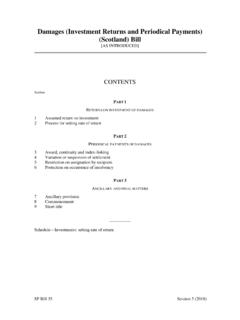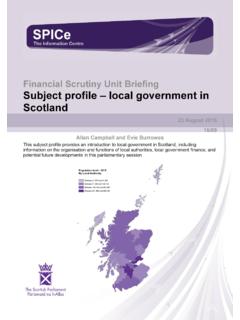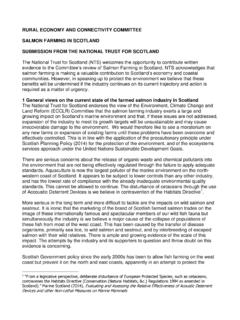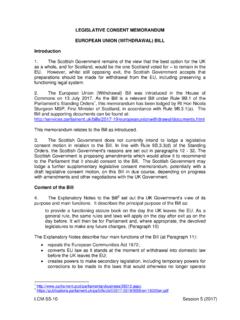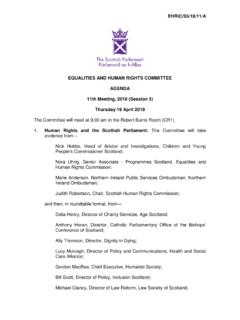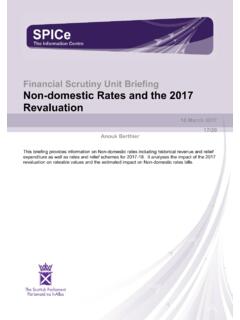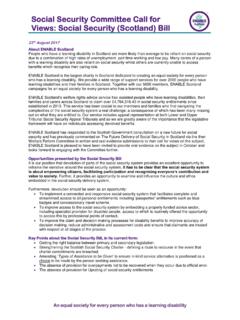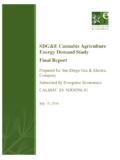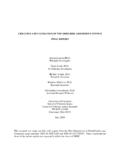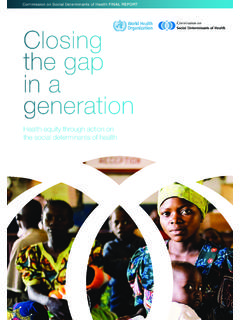Transcription of The Scottish Parliament Sexual Harassment and …
1 The Scottish Parliament Sexual Harassment and Sexist Behaviour Survey final report 26th February 2018 Contact information Ruth Bryan, Associate Director Contents Executive summary .. 3 1 Background and objectives .. 6 2 Method and sample .. 7 3 Sample profile .. 10 4 Experience of Sexual Harassment and sexist behaviour .. 11 5 Witnessing Sexual Harassment and sexist behaviour .. 20 6 Reporting incidences of Sexual Harassment and sexist behaviour .. 28 7 Other feedback .. 37 8 Conclusions .. 39 Appendix 1: Survey questionnaire .. 42 Appendix 2: Technical appendix .. 53 3 10130 Sexual Harassment and Sexual behaviour survey final report Executive summary Research objectives The aim of this research was to provide the Scottish Parliamentary Corporate Body with baseline information on the extent to which staff1 have experienced or witnessed Sexual Harassment and sexist behaviour, both at Holyrood and in constituency and regional offices.
2 It also explored staff awareness of reporting procedures, whether they report incidents and the reasons why they might not do so. Method and sample A self-completion survey was conducted among the target audience: MSPs; MSP staff, including interns; staff of the Parliament ; staff of the Scottish Government who work at Holyrood; agency workers, contractors and members of the media who work at the Parliament . The survey was conducted online, with hard copy questionnaires available to staff without a parliamentary email account. A total of 1,039 questionnaires were completed (1,005 online and 34 hard copies).
3 The overall response rate was , but this was higher for the online survey ( ) than for the paper version ( ). Key research findings Experience of Sexual Harassment and sexist behaviour The majority of respondents (78%) said they had not experienced Sexual Harassment or sexist behaviour while working at the Parliament . However, a fifth overall (20%) had experienced such behaviour (2% said they did not know). The most commonly mentioned types of behaviour reported were having comments of a sexist nature directed toward them (12%), and/or receiving looks, leers, comments or gestures of a Sexual nature, including comments about their body or appearance (10%).
4 Five per cent reported unwanted physical contact and 4% had been asked questions of a Sexual nature. Women were more likely than men to have experienced any kind of Sexual Harassment or sexist behaviour 30% of women compared to 6% of men. Specifically, women were more likely to report : having comments of a sexist nature directed towards them (20% v 2%); receiving looks, leers etc. (16% v 3%) and unwanted physical contact (9% v 1%). Among those who had experienced Sexual Harassment , 45% said the perpetrator was an MSP, 40% said the perpetrator was a member of the Scottish Parliament staff and 20% said a member of MSP staff was responsible.
5 Proportions were similar in relation to the perpetrator(s) of sexist behaviour. The majority reported that the perpetrator(s) were either sometimes or always in a position of authority (58% for Sexual Harassment , 71% for sexist behaviour experienced). In the vast majority of cases the perpetrator was of a different gender to the respondent (94% for Sexual Harassment ; 95% for sexist behaviour) while the perpetrator was of the same gender in 12% of cases (for both types of behaviour). Although findings should be treated with caution due to the 1 Unless referring to a specific staff group 'Staff of the Parliament /SPS staff', ' Scottish Government staff' or 'MSP staff' etc.
6 , the use of the term staff in this report refers to all survey respondents, including MSPs. 4 10130 Sexual Harassment and Sexual behaviour survey final report small number of men who had experienced Sexual Harassment (21), men were more likely than women to report that the perpetrator was the same gender as them (13 of the 21 respondents said this, compared to 3% of women four respondents in total). It therefore appears that the perpetrators of this type of behaviour tend to be male, regardless of the gender of the victim. Respondents were asked what action, if any, they had ever taken in relation to any incidents they had experienced.
7 The most common response, given by 45% in relation to sexist behaviour and 40% in relation to Sexual Harassment , was that they had not done anything about it. The most frequently reported actions were to tell a colleague (36% for Sexual Harassment ; 32% for sexist behaviour) and to remove themselves from the situation (34% and 20% respectively). Just under a fifth (18%) confronted the perpetrator about sexist behaviour, while 10% did this in response to Sexual Harassment . Only very small proportions said they had reported the behaviour they experienced (5% for both types of behaviour), and none had told a TUS representative about the incident(s).
8 Witnessing Sexual Harassment and sexist behaviour Overall, 29% of respondents said that they had witnessed Sexual Harassment or sexist behaviour. Two thirds (67%) said they had not, and 6% said they did not know. The most commonly witnessed incidents were colleagues having comments of a sexist nature directed toward them (15%) and colleagues receiving looks, leers, comments or gestures of a Sexual nature, including comments about their body or appearance, from someone who works at/for the Parliament (14%). The most common response to witnessing Sexual Harassment was to talk to or offer support to the victim (mentioned by 36%).
9 While 16% told a colleague, 8% confronted the perpetrator and 7% intervened to help the victim, a third (32%) said they did not do anything about Sexual Harassment they witnessed or were aware of. Responses were similar in relation to sexist behaviour, although the most common response was that they did not do anything about it (33%) and 30% talked to/offered support to the victim. A greater proportion of respondents confronted the perpetrator (14%) or intervened to help the victim (13%) compared to incidents of Sexual Harassment , and a similar proportion told a colleague (15%).
10 Reporting incidences of Sexual Harassment and sexist behaviour Respondents were asked how confident they were that they knew how to report incidents of Sexual Harassment or sexist behaviour. Just over three quarters (77%) said they were confident that they knew how to do this (38% very confident; 39% quite confident) while 23% said they were not confident about how to do this (17% not very confident; 5% not at all confident). Respondents who had experienced both Sexual Harassment and sexist behaviour were less confident than those who had experienced neither (47% compared to 82%).
